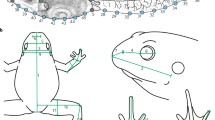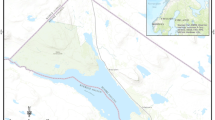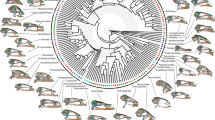Abstract
Environmental induced developmental plasticity occurs in many organisms and it has been suggested to facilitate biological diversification. Here we use ranid frogs to examine whether morphological changes derived from adaptive developmental acceleration in response to pool drying within a species are mirrored by differences among populations and across species. Accelerated development in larval anurans under pool drying conditions is adaptive and often results in allometric changes in limb length and head shape. We examine the association between developmental rate and morphology within population, among populations in divergent environments, and among species inside the Ranidae frog family, combining experimental approaches with phylogenetic comparative analyses. We found that frogs reared under decreasing water conditions that simulated fast pool drying had a faster development rate compared to tadpoles reared on constant water conditions. This faster developmental rate resulted in different juvenile morphologies between the two pool drying conditions. The association between developmental rate and morphology found as a result of plasticity was not mirrored by differences among populations that differed in development, neither was it mirrored among species that differed in development rate. We conclude that morphological differences among populations and species were not driven by variation in developmental time per se. Instead, selective factors, presumably operating on locomotion and prey choice, seem to have had a stronger evolutionary effect on frog morphology than evolutionary divergences in developmental rate in the ranid populations and species studied.





Similar content being viewed by others
References
Abramoff, M. D., Magelhaes, P. J., & Ram, S. J. (2004). Image Processing with ImageJ. Biophotonics International, 11, 36–42.
APHA. (1985). Standard methods for the examination of water and wastewater (16th ed.). Washington, DC: American Public Health Association.
Altwegg, R., & Reyer, H. U. (2003). Patterns of natural selection on size at metamorphosis in water frogs. Evolution, 57, 872–882.
Anderson, D. R., & Burnhamn, K. P. (2002). Avoiding pitfalls when using information-theoretic methods. The Journal of Wildlife Management, 66, 912–918.
Baskett, M. L., Weitz, J. S., & Levin, S. A. (2007). The evolution of dispersal in reserve networks. The American Naturalist, 170, 59–78.
Benjamini, Y., & Hochenberg, Y. (1995). Controlling the false discovery rate: A practical and powerful approach to multiple testing. Journal of the Royal Statistical Society, 57, 289–300.
Blem, C. R., Steiner, J. W., & Miller, M. A. (1978). Comparison of jumping abilities of the cricket frogs Acris gryllus and Acris crepitans. Herpetologica, 34, 288–291.
Braendle, C., & Flatt, T. (2006). A role for genetic accommodation in evolution? BioEssays, 28, 868–873.
Buchholz, D. R., & Hayes, T. B. (2002). Evolutionary patterns of diversity in spadefoot toad metamorphosis (Anura: Pelobatidae). Copeia, 2002, 180–189.
Carvajal-Rodríguez, A., de Uña-Álvarez, J., & Rolán-Álvarez, E. (2009). A new multitest correction (SGoF) that increases its statistical power when increasing the number of tests. BMC Bioinformatics, 10, 1–14.
Crispo, E. (2007). The Baldwin effect and genetic assimilation: Revisiting two mechanisms of evolutionary change mediated by phenotypic plasticity. Evolution, 61, 2469–2479.
Denver, R. J., Mirhadi, N., & Phillips, M. (1998). Adaptive plasticity in amphibian metamorphosis: Response of Scaphiopus hammondii tadpoles to habitat desiccation. Ecology, 79, 1859–1872.
Draghi, J. A., & Whitlock, M. C. (2012). Phenotypic plasticity facilitates mutational variance, genetic variance, and evolvability along the major axis of environmental variation. Evolution, 66, 2891–2902.
Ebenman, B. (1992). Evolution in organisms that change their niches during the life-cycle. American Naturalist, 139, 990–1021.
Emerson, S. B. (1978). Allometry and jumping in frogs: Helping the twain to meet. Evolution, 32, 551–564.
Emerson, S. B. (1986). Heterochrony and frogs: The relationship of a life history trait to morphological form. American Naturalist, 127, 167–183.
Frost, D. R., Grant, T., Faivovich, J., Bain, R. H., Haas, A., et al. (2006). The amphibian tree of life. Bulletin of the American Museum of Natural History, 297, 1–370.
Fusco, G., & Minelli, A. (2010). Phenotypic plasticity in development and evolution: Facts and concepts. Philosophical Transactions of the Royal Society B: Biological Sciences, 365, 547–556.
Gomez-Mestre, I., & Buchholz, D. R. (2006). Developmetal plasticity mirrors differences among taxa in spadefoot toads linking plasticity and diversity. Proceedings of the National Academy of Sciences USA, 103, 19021–19026.
Gomez-Mestre, I., & Jovani, R. (2013). A heuristic model on the role of plasticity in adaptive evolution: Plasticity increases adaptation, population viability and genetic variation. Proceedings of the Royal Society of London B, 280, 1869.
Gomez-Mestre, I., Saccoccio, V. L., Iijima, T., Collins, E. M., Rosenthal, G. G., & Warkentin, K. M. (2010). The shape of things to come: Linking developmental plasticity to post-metamorphic morphology in anurans. Journal of Evolutionary Biology, 23, 1364–1373.
Gosner, K. L. (1960). A simple table for staging anuran embryos and larvae with notes on identification. Herpetologica, 16, 183–190.
Hanken, J. (1992). Life history and morphological evolution. Journal of Evolutionary Biology, 5, 549–557.
Hoskin, C. (2010). Breeding behaviour of the Barred frog Mixophyes coggeri. Memoirs of the Queensland Museum—Nature, 55, 1–7.
James, R., & Wilson, R. (2008). Explosive jumping: Extreme morphological and physiological specializations of Australian rocket frogs (Litoria nasuta). Physiological and Biochemical Zoology, 81, 176–185.
Johansson, F., Lind, M. I., & Lederer, B. (2010). Trait performance correlations across life stages under environmental stress conditions in the common frog, Rana temporaria. PLoS One, 5(7), e11680.
Johansson, F., & Richter-Boix, A. (2013). Within-population developmental and morphological plasticity is mirrored in between- population differences: Linking plasticity and diversity. Evolutionary Biology, 40, 494–503.
Johansson, F., Veldhoen, N., Lind, M. I., & Helbing, C. (2013). Phenotypic plasticity in the hepatic transcriptome of the European common frog (Rana temporaria): The interplay between environmental induction and geographic lineage on developmental response. Molecular Ecology, 22, 5608–5623.
Kulkarni, S., Gomez-Mestre, I., Moskalik, C., Storz, B., & Buchholz, D. (2011). Evolutionary reduction of developmental plasticity in desert spadefoot toads. Journal of Evolutionary Biology, 24, 2445–2455.
Laugen, A. T., Kruuk, L. E., Laurila, A., Räsänen, K., Stone, J., & Merilä, J. (2005). Quantitative genetics of larval life-history traits in Rana temporaria in different environmental conditions. Genetical Research, 86, 161–170.
Laurila, A., & Kujasalo, J. (1999). Habitat duration, predation risk and phenotypic plasticity in common frog tadpoles. Journal of Animal Ecology, 68, 1123–1132.
Lewis, B., & Rohweder, D. (2005). Distribution, habitat, and conservation status of the Giant Barred Frog, Mixophyes iteratus in the Bungawalbin catchment, northeastern New South Wales. Pacific Conservation Biology, 11, 189–197.
Lind, M. I., Ingvarsson, P. K., Johansson, H., Hall, D., & Johansson, F. (2011). Gene flow and selection on phenotypic plasticity in an island system. Evolution, 65, 684–697.
Lind, M., & Johansson, F. (2007). The degree of adaptive phenotypic plasticity is correlated with spatial environmental heterogeneity experienced by island populations of Rana temporaria. Journal of Evolutionary Biology, 20, 1288–1297.
Minelli, A., Brena, C., Deflorian, G., Maruzzo, D., & Fusco, G. (2006). From embryo to adult—beyond the conventional periodization of arthropod development. Development genes and evolution, 216, 373–383.
Moczek, A. P., Sultan, S., Foster, S., Ledon-Rettig, C., Dworkin, I., Nijhout, H. F., et al. (2011). The role of developmental plasticity in evolutionary innovation. Proceedings of the Royal Society of London B B, 278, 2705–2713.
Moran, N. A. (1994). Adaptation and constraint in the complex life cycles of animals. Annual Review of Ecology and Systematics, 25, 73–600.
Newman, R. A. (1992). Adaptive plasticity in amphibian metamorphosis. BioScience, 42, 671–678.
Orme, D., Freckleton, R., Thomas, G., Petzoldt, T., Fritz, S., Isaac, N., et al. (2012). Caper: Comparative analyses of phylogeneticsand evolution in R. version 0.5. http://CRAN.R-project.org/package=caper.
Pechenik, J. A. (1999). On the advantages and disadvantages of larval stages in benthic marine invertebrate life cycles. Marine Ecology Progress Series, 177(1), 269–297.
Pechenik, J. A. (2006). Larval experience and latent effects—metamorphosis in not a new beginning. Integrative and Comparative Biology, 46, 323–333.
Pfennig, D., Wund, M. A., Snell-Rood, E. C., Cruickshank, T., Schlichting, C. D., & Moczek, A. P. (2010). Phenotypic plasticity’s impacts on diversification and speciation. Trends in Ecology and Evolution, 25, 459–467.
Pigliucci, M. (2001). Phenotypic plasticity: Beyond nature and nurture. Baltimore and London: The John Hopkiss University Press.328 pp.
Pinheiro, J., Bates, D., DebRoy, S., Sarkar, D. & R. C. team. (2008). Nlme: Linear and nonlinear mixed effects models. R package version 3.1-90.
Pyron, R. A., & Wiens, J. J. (2011). A large-scale phylogeny of Amphibia including over 2,800 species, and a revised classification of extant frogs, salamanders, and caecilians. Molecular Phylogenetics and Evolution, 61, 543–583.
Pyron, R. A., & Wiens, J. J. (2013). Large-scale phylogenetic analyses reveal the causes of high tropical amphibian diversity. Proceedings of the Royal Society of London B: Biological Sciences, 280(1770), 20131622.
Revell, L. J. (2010). phytools: An R package for phylogenetic comparative biology (and other things). Methods in Ecology and Evolution, 3, 217–223.
Richter-Boix, A., Llorente, G. A., & Montori, A. (2006). Effects of phenotypic plasticity on post-metamorphic traits during pre-metamorphic stages in the anuran Pelodytes punctatus. Evolutionary Ecology Research, 8, 309–320.
Richter-Boix, A., Tejedo, M., & Rezende, E. L. (2011). Evolution and plasticity of anuran larval development in response to desiccation. A comparative analysis. A comparative analysis. Ecol Evol., 1, 15–25.
Rose, C. S. (2005). Integrating ecology and developmental biology to explain the timing of frog metamorphosis. Trends in Ecology and Evolution, 20, 129–135.
Savage, R. M. (1961). The ecology and life history of the common frog. London: Sir Isac Pitman and Sons.
Snell-Rood, E. C., Van Dyken, J. D., Cruickshank, T., Wade, M. J., & Moczek, A. P. (2010). Toward a population genetic framework of developmental evolution: The costs, limits, and consequences of phenotypic plasticity. BioEssays, 32, 71–81.
Stoks, R., & Córdoba-Aguilar, A. (2012). Evolutionary ecology of odonata: A complex life cycle perspective. Annual Review of Entomology, 57, 249–265.
Suzuki, Y., & Nijhout, H. F. (2006). Evolution of polyphenism by genetic accommodation. Science, 311, 650–652.
Tejedo, M., Marangoni, F., Pertoldi, C., Richter-Boix, A., Laurila, A., Orizaola, G., et al. (2010). Contrasting effects of environmental factors during larval stage on morphological plasticity in post-metamorphic frogs. Climate Research, 43, 31–39.
Tejedo, M., & Reques, R. (1994). Plasticity in metamorphic traits of natterjack tadpoles: The interactive effects of density and pond duration. Oikos, 71, 295–304.
Vidal-García, M., Byrne, P. G., Roberts, J. D., & Keogh, J. S. (2014). The role of phylogeny and ecology in shaping morphology in 21 genera and 127 species of Australo-Papuan myobatrachid frogs. Journal of evolutionary biology, 27, 181–192.
Waddington, C. H. (1942). Canalization of development and the inheritance of acquired characters. Nature, 150, 563–565.
Waddington, C. H. (1952). Selection of the genetic basis for an acquired character. Nature, 169, 278.
Watkins, T. B. (2001). A quantitative genetic test of adaptive decoupling across metamorphosis for locomotor and life-history traits in the pacific tree frog, Hyla regilla. Evolution, 55, 1668–1677.
West-Eberhard, M. J. (2003). Developmental plasticity and evolution (p. 794). New York: Oxford University Press.
West-Eberhard, M. J. (2005). Developmental plasticity and the origin of species differences. Proceedings of the National Academy of Sciences USA, 102, 6543–6549.
Wilbur, H. M., & Colins, J. P. (1973). Ecological aspects of amphibian metamorphosis. Science, 182, 1305–1314.
Wilson, A. D. M., & Krause, J. (2012). Personality and metamorphosis: Is behavioral variation consistent across ontogenetic niche shifts? Behavioral Ecology, 23, 1316–1323.
Wund, M. A., Baker, J. A., Clancy, B., Golub, J., & Fosterk, S. A. (2008). A test of the “Flexible stem” model of evolution: Ancestral plasticity, genetic accommodation, and morphological divergence in the threespine stickleback radiation. The American Naturalist, 172, 449–462.
Zeng, C., Gomez-Mestre, I., & Wiens, J. J. (2014). Evolution of rapid development in spadefoot toads is unrelated to arid environments. PLoS One, 9, e96673.
Acknowledgments
We thank J.J. Wiens for assistance in deriving the phylogeny used in this article from a previously published large-scale phylogeny. We also tank J. Cabot and M. Calvo for granting access to the herpetological collections at Estación Biológica de Doñana and Museo Nacional de Ciencias Naturales, respectively. FJ was supported by The Swedish Research Council.
Author information
Authors and Affiliations
Corresponding author
Ethics declarations
Conflict of interest
The authors declare that they have no conflict of interest.
Electronic supplementary material
Below is the link to the electronic supplementary material.
Rights and permissions
About this article
Cite this article
Johansson, F., Richter-Boix, A. & Gomez-Mestre, I. Morphological Consequences of Developmental Plasticity in Rana temporaria are not Accommodated into Among-Population or Among-Species Variation. Evol Biol 43, 242–256 (2016). https://doi.org/10.1007/s11692-015-9363-2
Received:
Accepted:
Published:
Issue Date:
DOI: https://doi.org/10.1007/s11692-015-9363-2




